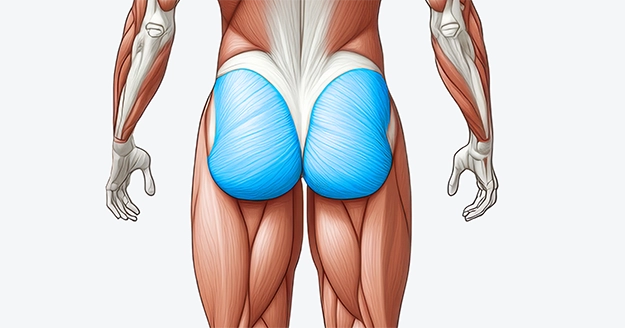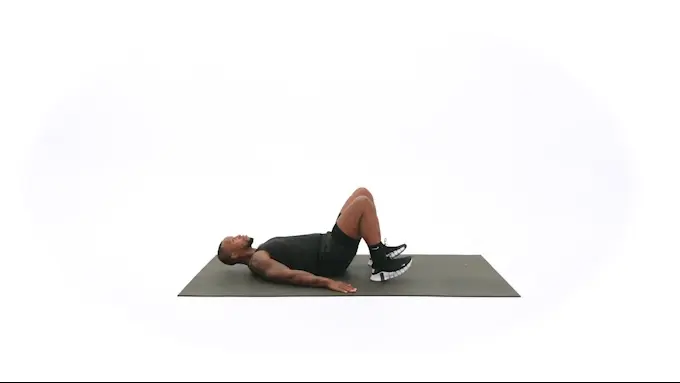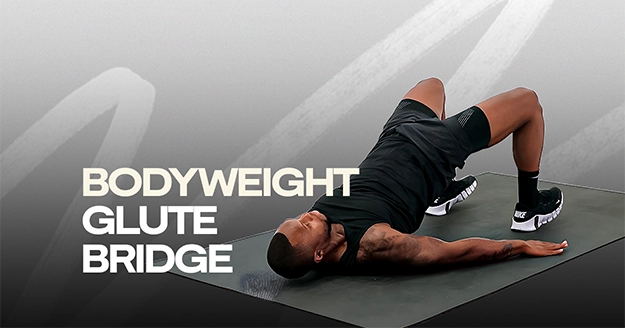Exercise Profile
Bodyweight Glute Bridge Overview
The Bodyweight Glute Bridge or commonly known as just “Glute Bridge” is a beginner-friendly bodyweight exercise that targets the glutes. You can easily add this exercise to your strength training routine.
For beginners, the bodyweight glute bridge is a great way to activate and strengthen the glutes without needing any equipment. More advanced fitness enthusiasts can modify the exercise by adding resistance bands or performing single-leg variations to increase intensity and challenge the muscles further.
Glute bridges can be incorporated into your routine in several ways. They work well as a warm-up for glutes before a lower-body exercise regimen or as a part of a full-body workout.

Bodyweight Glute Bridge Instructions
Here’s a simple 4-step bodyweight glute bridge guide to help you do this exercise effectively:
Step 1: Start the exercise by lying on a leveled floor with your arms at your sides.
Step 2: Bend your knees and pull your heels toward your butt until your shins are perpendicular to the floor. Engage your glutes and abs.
Step 3: Breathe out as you lift your hips by pushing through your heels. Do this until your body forms a straight line from your knees to your shoulders.
Step 4: Pause and squeeze your glutes as tight as you can at the top, then inhale as you slowly lower your hips back to the floor. Continue for the desired number of reps.

Common Bodyweight Glute Bridge Variations
The glute bridge is an excellent beginner’s exercise, but you can make it more challenging with these variations:
Bodyweight Glute Bridge Tips
- Squeeze your glutes really tight at the top of the movement while keeping a straight back.
- Perform your reps in a controlled manner.
- Inhale as you lower your hips. Exhale as you push through your heels to lift them back up.
- Focus on quality reps rather than quantity to maximize muscle engagement.
Bodyweight Glute Bridge Common Mistakes
- Moving Too Quickly: Rushing through your sets increases the risk of injury.
- Not Engaging the Glutes: Simply going through the motion without squeezing the glutes reduces the impact of the exercise.
- Overarching Lower Back: Lifting your hips too high can cause your lower back to arch, which shifts the focus away from your glutes and can lead to a strain.
Frequently Asked Questions
What is the difference between a barbell glute bridge and a thrust?
It’s easy to think that these two are similar since they target the same muscle. However, the main difference is that in a hip thrust, your upper body is typically elevated on a bench or step, while in a traditional glute bridge bodyweight, your back and shoulders remain on the ground.
How long should you hold a glute bridge?
You can safely start with three sets of 15 to 20 reps, holding each rep for 1-2 seconds using just your body weight. You can also opt for lower reps but longer duration (30 seconds). As you progress, you can gradually increase your sets, reps, or incorporate added weights to challenge yourself further.
Do glute bridges make your glutes bigger?
When performed correctly and combined with progressive overload, bodyweight glute bridge (exercise) can effectively strengthen and build your glute muscles over time.
What muscles do the glute bridge work?
It primarily targets the glutes while also working the core and hamstrings.
Post your post-workout selfies in IG and tag @trainestapp, #trainest, or DM them to us to get a shoutout on Trainest Stories!


